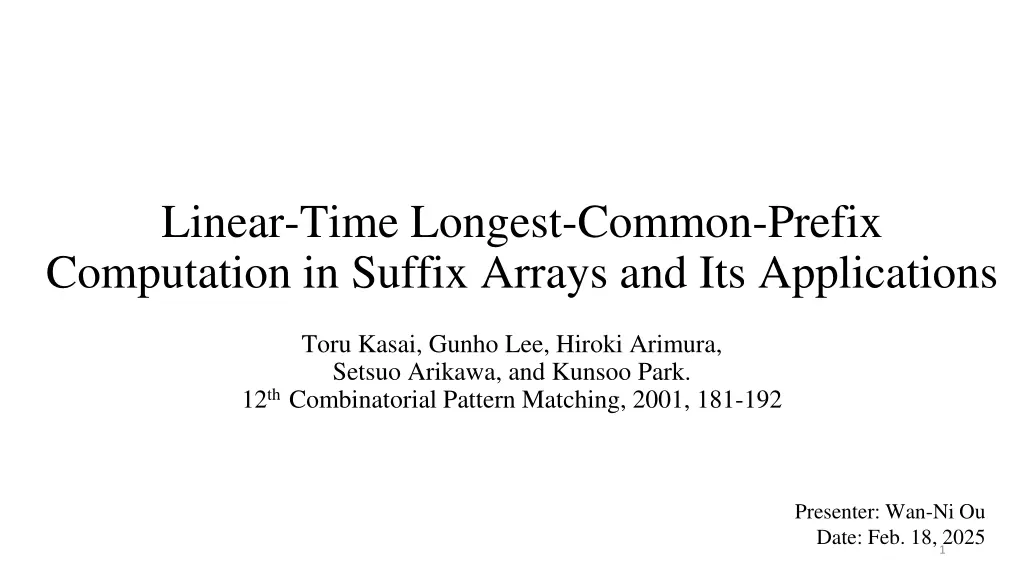
Efficient Computation of Longest Common Prefix in Suffix Arrays
"Learn about a linear-time algorithm for calculating longest common prefix in suffix arrays, essential for block-sorting compression and simulating suffix trees with suffix arrays. Explore the applications and implications of this algorithm in pattern matching. Presented by Wan-Ni Ou."
Download Presentation

Please find below an Image/Link to download the presentation.
The content on the website is provided AS IS for your information and personal use only. It may not be sold, licensed, or shared on other websites without obtaining consent from the author. If you encounter any issues during the download, it is possible that the publisher has removed the file from their server.
You are allowed to download the files provided on this website for personal or commercial use, subject to the condition that they are used lawfully. All files are the property of their respective owners.
The content on the website is provided AS IS for your information and personal use only. It may not be sold, licensed, or shared on other websites without obtaining consent from the author.
E N D
Presentation Transcript
Linear-Time Longest-Common-Prefix Computation in Suffix Arrays and Its Applications Toru Kasai, Gunho Lee, Hiroki Arimura, Setsuo Arikawa, and Kunsoo Park. 12th Combinatorial Pattern Matching, 2001, 181-192 Presenter: Wan-Ni Ou Date: Feb. 18, 2025 1
Abstract We present a linear-time algorithm to compute the longest common prefix information in suffix arrays. As two applications of our algorithm, we show that our algorithm is crucial to the effective use of block-sorting compression, and we present a linear-time algorithm to simulate the bottom-up traversal of a suffix tree with a suffix array combined with the longest common prefix information. 2
Suffix array (1/2) Pos[k] = i 3
Suffix array (2/2) Binary search finds pattern m in text n: O(m logn) Suffix array + LCP to find a pattern: O(m + logn) 4
Preliminary summary Suffix array: ( ) Pos[k] = i : k i substring. Rank [i] = k : Pos inverse function LCP array: LCP Goal: LCP Conbine suffix array and LCP 6
Height array (1/2) banana anana nana anana banana$ i = 1, rank[1] = 5, h = 0: k = Pos[Rank[i] - 1] = 2 while A[ i + h ] = = A[ k + h ] : h += 1 ; (banana, anana) => Height[5] = 0 i = 2, rank[2] = 4: k = Pos[Rank[i] - 1] = 4 while A[ i + h ] = = A[ k + h ] : h += 1 ; (anana, ana) => Height[4] = 3 h > 0 : h -= 1 = 2; 7
Height array (2/2) nana na a ana banana$ i = 3, rank[3] = 7, h = 2: k = Pos[Rank[i] - 1] = 5 while A[ i + h ] = = A[ k + h ] : h += 1 ; (nana, na) => Height[7] = 2 h > 0 : h -= 1 = 1; i = 4, rank[4] = 3, h = 1: k = Pos[Rank[i] - 1] = 6 while A[ i + h ] = = A[ k + h ] : h += 1 ; (ana, a) => Height[4] = 1 h > 0 : h -= 1 = 0; 8
Branching Substring If S = LCP(Ai, Aj), we call S is a branching substring. E.g. Ai = anana, Aj = ana ana is a branching substring, since it s the LCP of anana and ana . 9
Traverse with Height array (L, R, H) = (start, end, length) // e.g. banana, ana = (2, 4, 3) 10
Result & Conclusion Data: an English text of 5.3MB Binary search: O(m logn) Suffix array + LCP: O(m + logn) 11
Thanks 12
Abstract We present a linear-time algorithm to compute the longest common prefix information in suffix arrays. As two applications of our algorithm, we show that our algorithm is crucial to the effective use of block-sorting compression, and we present a linear-time algorithm to simulate the bottom-up traversal of a suffix tree with a suffix array combined with the longest common prefix information. 13
Bottom-Up Traverse (L, R, H) = (start, end, length) 14
Compute LCP (using Pos/Rank Array) E.g. banana$ Lcp(anana, ana) = 3 Lcp(nana, na) = 2 i = 1, rank[1] = 5: Pos[5 - 1] = Pos[4] = 2 Lcp(1, 2) = 0 (banana, anana) => Height[5] = 0 i = 2, rank[2] = 4: Pos[4 1 ] = Pos[3] = 4 Lcp(2, 4) = 3 (anana, ana) => Height[4] = 3 Lcp(a, anana) = min(1, 3) = 1 i = 3, rank[3] = 7: Pos[7 1 ] = Pos[6] = 5 Lcp(3, 5) = 2 (nana, na) =>Height[7] = 2 15
Compute LCP (using Pos/Rank Array) i = 4, rank[4] = 3: Pos[3 - 1] = Pos[2] = 6 Lcp(4, 6) = 1 (ana, a) => Height[3] = 1 i = 5, rank[5] = 6: Pos[6 1 ] = Pos[5] = 1 Lcp(5, 1) = 0 (na, banana) => Height[6] = 0 i = 6, rank[6] = 2: Pos[2 1 ] = Pos[1] = 7 Lcp(6, 7) = 0 (a, $) =>Height[2] = 0 i = 7, rank[7] = 1, but Pos[7] = $ loop finish. Height[0, 0, 1, 3, 0, 0, 2] 16
Conclusion Usi 17
